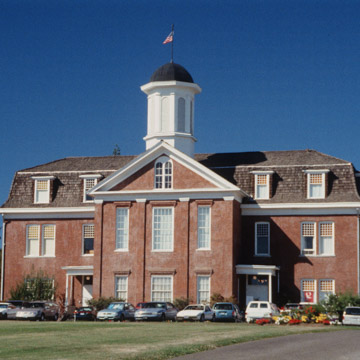You are here
Benton County Historical Society and Museum
One of the Oregon’s earliest educational structures, Philomath College was founded in 1865 by the Church of the United Brethren of Christ, a Protestant denomination that originated in eighteenth-century Mennonite and German Reformed communities in eastern Pennsylvania and eventually became centered in Huntington, Indiana. Individual United Brethren families settled in the Oregon Territory as early as the mid-1840s, and by the 1850s the Church sent more families west. Education was an essential principle of the church, and in February 1865 a group of United Brethren residents in Benton County resolved to build the area’s first primary school (with higher grades added as continuing students advanced) on an 8-acre portion of the Henderson donation land claim, located about four miles west of Corvallis.
The school—and the town that developed around it—was named Philomath, meaning “lover of learning” in Greek. In the mid-nineteenth century, the Church established eight colleges but Philomath was its only educational institution in the West. Due to the relatively low numbers of church members in the Pacific Northwest, however, Philomath College was beset with financial problems from the start.
The initial plan called for a broad rectangular brick building with a projecting pedimented central section enhanced by four wide brick pilasters and surmounted by a large octagonal cupola; flanking side wings were to feature double-pitched mansard roofs with flared eaves. Due to limited resources, only the central block was initially built in 1865–1867, with a pronounced door in the center of the ground floor. Students made the bricks using an on-site kiln and masons laid the stone foundation. The west wing was built in 1904–1905, followed by the east wing in 1905–1907—both built using student labor and following the original plans. During this expansion, the original central entrance was rebuilt as a window, and two new entrances were located at the innermost bays of the new wings. At first glance, because of the brick pilasters, pediment, and large cupola, the building might be considered Colonial Revival. The mansard roof and date of construction, however, suggest the Second Empire style. Yet the broad, curving flare of the roof could have been inspired by the Pennsylvania German roots of the United Brethren.
Declining church support in the 1920s was exacerbated by declining enrollment — particularly in the secondary classes due to the concurrent increase in Oregon’s public municipal high schools. More serious, no doubt, was the significant growth of the state-funded colleges, most notably the neighboring Oregon Agricultural College (soon renamed Oregon State University), only four miles to the east. Philomath College closed in 1928. Over the next four decades, the United Brethren community used the building for church services. When the sect ultimately became part of the Methodist Church, the structure was abandoned in favor of the new Methodist church built adjacent to the college.
The Philomath and Corvallis communities rallied for the building’s preservation, and it was restored in the 1970s. The Benton County Historical Society relocated to Philomath College in 1980, and opened the building to the public as a museum. Seldom does such a solidly constructed building intended for a different time and function later become the home of a public institution whose purposes are so aligned with that of the original owners.
References
Writing Credits
If SAH Archipedia has been useful to you, please consider supporting it.
SAH Archipedia tells the story of the United States through its buildings, landscapes, and cities. This freely available resource empowers the public with authoritative knowledge that deepens their understanding and appreciation of the built environment. But the Society of Architectural Historians, which created SAH Archipedia with University of Virginia Press, needs your support to maintain the high-caliber research, writing, photography, cartography, editing, design, and programming that make SAH Archipedia a trusted online resource available to all who value the history of place, heritage tourism, and learning.














